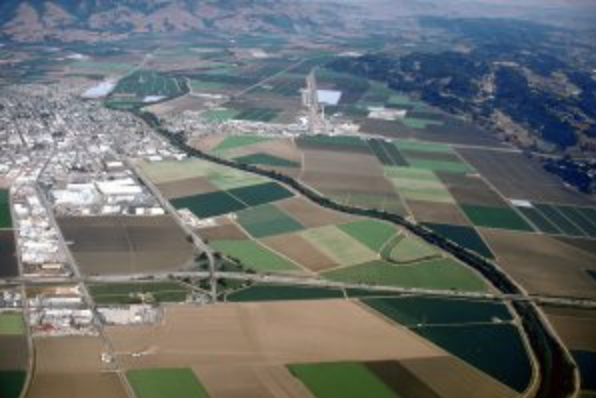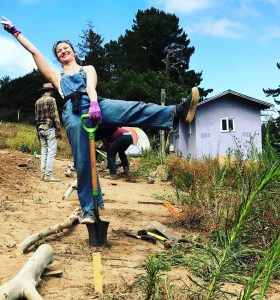Our home on the California Central Coast has been called the Salad Bowl of the World. The climate, soil, and infrastructure make it a pretty ideal place to grow food. Driving down our canyon into the valley, we look out the car window onto countless acres owned by familiar brands: Dole, Driscolls, Earthbound. Something has struck us, though, in our research before moving here, and in our experience of living here so far: In San Benito County, the people who are working in the fields to grow fresh food don’t necessarily have access to the food they grow.

Anecdotally, we drive 20-30 minutes to get to a grocery store. The seasonal farmers markets in the area are saturated with food trucks and other prepared food, with only a sprinkling of stands offering fresh produce. Agriculture is San Benito County’s largest industry. Yet, in a place with such a thriving food economy, it is difficult to access fresh, local produce. The Salinas Valley and surrounding areas are “America’s Salad Bowl” due to the amount of crops grown here and exported to other regions. Because of a lack of access to fresh food here in the region, and wages that are often inadequate to afford healthy food, 8,000 households in San Benito County experience food insecurity.
According to the Nutrition and Fitness Collaborative of the Central Coast, “food insecurity occurs when food access is insufficient or uncertain for at least one person in the household at some point in the year.” According to a survey conducted in 2017 by the San Benito Health Department, “48% [of those surveyed] said they often or sometimes worried whether their food would run out before they had money to buy more, 50% reported that they often or sometimes couldn’t afford to eat healthy meals, a shocking 21% stated that some or almost every month they or their children did not eat for a whole day because there wasn’t enough money for food.”
Food insecurity and obesity often coexist, as families cut back on the quality of meals to stretch their food budget. A poor diet can lead to poor health, and increased risk of obesity, diabetes, heart disease, and cancers. According to a 2006 report prepared by Brian Fulfrost and Phil Howard of UC Santa Cruz, “Overweight and obesity rates are increasing among children, and nearly one-third of seventh graders in the Central Coast region fall into these categories. Approximately 54% of adults surveyed in the Central Coast reported they were overweight or obese, with the number rising to 64% for Latino respondents.” A poor diet is especially a challenge to children. The Nutrition and Fitness Collaborative of the Central Coast reports that “children from food insecure households have been shown to score lower on measures of arithmetic skills while also being more likely to have repeated a grade and more likely to have been seen buy a psychologist. Food insecure teenagers were more likely to have been suspended from school and have difficulty forming relationships.” Fulfrost and Howard suggest that “counties with more than 50% of the population residing more than 10 miles from a large food retailer could be considered ‘food deserts’ and that these counties are clustered in areas with high poverty rates.”

Interestingly, climate change is playing a role in increasing food insecurity. In excessive heat, farm workers are given the option between working in potentially dangerous temperatures, or going home and losing wages. The number of days reaching high temperatures is increasing. As temperatures spike, food insecure populations face increased insecurity and health risk.
According to this United States Department of Agriculture map, the San Benito County side of our town of Aromas would be considered a food desert with significant food insecurity. Our area is designated a “Low-income census tract where more than 100 housing units do not have a vehicle and are more than ½ mile from the nearest supermarket, or a significant number or share of residents are more than 20 miles from the nearest supermarket.” Looking around at all the produce grown right here, these statistics continue to surprise me. But these statistics are one of the reasons we saw a need for Terra Cultura in this particular area. Here, Terra Cultura can have a dramatic impact on the health and well-being of its community by providing fresh, local, affordable food, while supporting our neighbors in growing their own nutritious food through workshops and hands-on educational opportunities.
We at Terra Cultura are working hard to prepare our site and amend the soil. Soon we’ll plant our first crops, which, when harvested, will be available to the community via a pay-what-you-can farmstand, an affordable farmer’s market stall, and Community Supported Agriculture opportunities. Our produce will also be donated to our local Neighbors Helping Neighbors program where healthy food is donated to community members in need, serving over 200 people a month. It’s an incredibly busy time here at Terra Cultura. Our ecologically-minded regenerative land management methods are the best practices for the health of local plant, animal, and human ecosystems, but they take time, and many hands, to establish. If you’re in the neighborhood, stop by and lend a hand, and help us get wholesome food on the plates of those who need it.


A sad truth, beautifully presented including a plan for making it better. I am so proud of all of you!